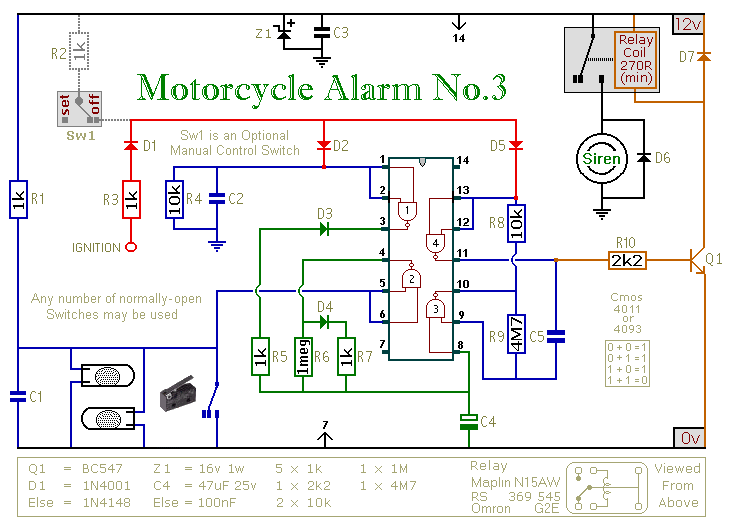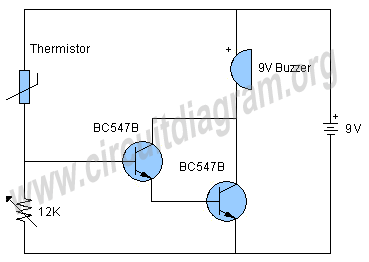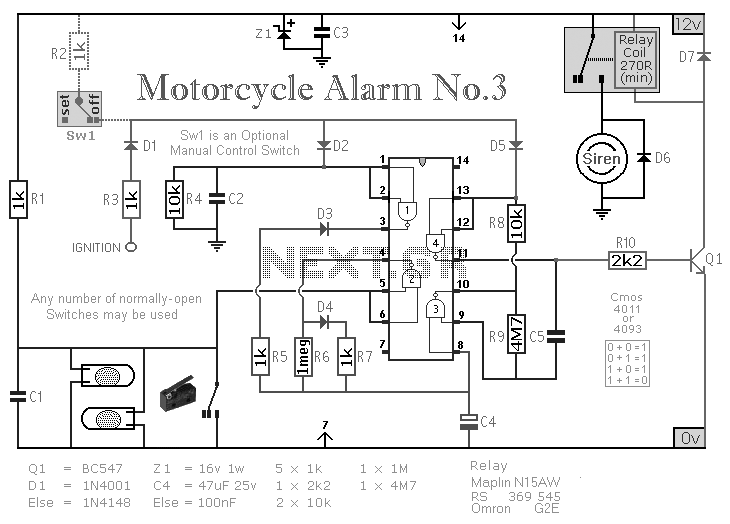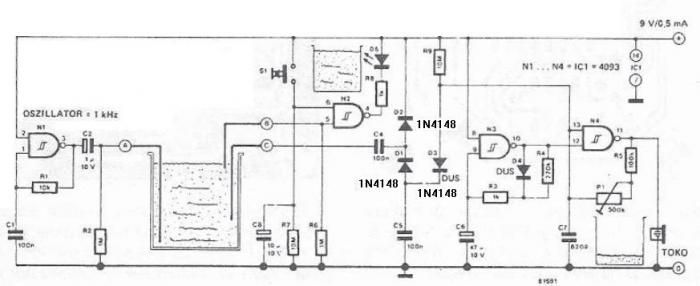
Build Your Own Motorcycle Alarm

This circuit includes an intermittent siren output with an automatic reset feature. It can be manually operated using a key switch or a concealed switch, and it can also be configured to activate automatically when the ignition is turned off. By incorporating external relays, the system can immobilize the motorcycle or flash the lights. Multiple normally-open switches may be used. For instance, "tilt" switches can be installed to close when the steering is moved, or when the motorcycle is lifted off its side-stand or pushed off its center-stand. Micro-switches can be utilized to secure removable panels and the lids of panniers. Once activated, the siren's on-off cycling rate is determined by resistors R9 and capacitor C5; increasing the value of C5 will slow the cycling down, while decreasing R9 will speed it up. The siren will sound as long as at least one switch is closed. Approximately thirty seconds after all switches are opened, the alarm will reset, with the timing dependent on the specific components used. The timing can be adjusted by modifying the values of R6 and/or C4. The circuit is designed to operate an electronic siren drawing 300 to 400 mA. Using the motorcycle's horn is generally discouraged, as it can be easily located and disconnected. However, if the horn is used, a relay capable of handling the required current must be connected to the siren output. It is essential to protect the circuit board and switches from moisture, as dampness can lead to malfunctions. The 1-amp in-line fuse should be connected as close as possible to the power source for optimal protection of the wiring. The installation specifics will vary based on the motorcycle model, limiting further guidance. The circuit's quiescent (standby) current is nearly zero, ensuring no battery drain. For manual operation, a key switch or hidden switch should be connected to the "off/set" terminals. For automatic operation, a connection from the ignition circuit to the "ignit" terminal is necessary, allowing the alarm to set itself upon turning off the ignition. This ignition wire should also be fitted with its own 1-amp fuse close to its power source. If the alarm is set while any switch is closed, the siren will sound, which may be disruptive at night. A modification can be made to monitor the switch states using LEDs; when all LEDs are off, it indicates that all switches are open, making it safe to activate the alarm. The components are arranged flat on the board, while those connecting adjacent tracks are mounted upright. The links are made of bare copper wire on the component side. The support material for this circuit includes a detailed circuit description, circuit simulation, parts list, step-by-step construction guide, and instructions for testing the completed alarm.
The circuit operates as a sophisticated security system for motorcycles, combining manual and automatic activation features. The intermittent siren output serves as an alarm mechanism, deterring potential theft or unauthorized use. The use of multiple normally-open switches enhances the system's responsiveness to various conditions, allowing for a tailored approach to security. For instance, the integration of tilt switches ensures that any movement of the motorcycle triggers the alarm, providing an additional layer of protection.
The adjustable timing components (R6, C4, R9, and C5) allow customization of the alarm's response, enabling users to set the desired duration for which the siren will sound after activation. This flexibility is particularly beneficial in adapting the system to different environments and user preferences.
The reliance on an electronic siren, rather than the motorcycle's horn, is a strategic choice to ensure the alarm system remains discreet and difficult to disable. The inclusion of a relay for higher current applications further enhances the reliability and safety of the circuit.
Protection against environmental factors is a critical consideration in the design. Ensuring that the circuit board and switches are shielded from moisture is essential for maintaining functionality in various weather conditions. The strategic placement of the 1-amp fuse close to the power source is a vital design aspect, safeguarding the wiring from potential overloads or shorts.
The design's quiescent current is nearly negligible, ensuring that the motorcycle's battery remains charged and operational, even when the alarm system is engaged. This feature is particularly advantageous for motorcycles that may not be used frequently, as it prevents battery drain.
Overall, this circuit represents a comprehensive approach to motorcycle security, combining advanced features with user-friendly operation and reliable performance. The inclusion of monitoring LEDs adds an innovative touch, providing visual confirmation of the alarm system's status and enhancing user confidence in its operation. The detailed support materials further ensure that users can successfully implement and test the system, maximizing its effectiveness in protecting their motorcycle.This circuit features an intermittent siren output and automatic reset. It can be operated manually using a key-switch or a hidden switch; but it can also be wired to set itself automatically when you turn-off the ignition. By adding external relays you can immobilize the bike - flash the lights etc. Any number of normally-open switches may be use d. Fit "tilt" switches that close when the steering is moved or when the bike is lifted off its side-stand or pushed forward off its centre-stand. Use micro-switches to protect removable panels and the lids of panniers etc Once activated - the rate at which the siren switches on and off is controlled by R9 & C5.
For example - increasing the value of C5 will slow it down - while reducing the value of R9 will make it faster. While at least one switch remains closed the siren will sound. About thirty seconds after all of the switches have been opened, the alarm will reset. How long it takes to switch off depends on the characteristics of the actual components used. You can adjust the time to suit your requirements by changing the value of R6 and/or C4. The circuit is designed to use an electronic Siren drawing 300 to 400mA. It`s not usually a good idea to use the bike`s own Horn because it can be easily located and disconnected.
However, if you choose to use the Horn, remember that the alarm relay is too small to carry the necessary current. Connect the coil of a suitably rated relay to the "Siren" output. This can then be used to sound the Horn - flash the lights etc. The circuit board and switches must be protected from the elements. Dampness or condensation will cause malfunction. Connect the 1-amp in-line fuse AS CLOSE AS POSSIBLE to your power source. This is VERY IMPORTANT. The fuse is there to protect the wiring - not the alarm. Exactly how the system is fitted will depend on the make of your particular machine - so I`m unable to provide any further help or advice in this regard.
The quiescent (standby) current of the circuit is virtually zero - so there is no drain on the battery. If you want to operate the alarm manually use a key-switch or a hidden switch connected to the "off/set" terminals.
For automatic operation connect a wire from the ignition circuit to the "ignit" terminal. Then every time you turn-off the ignition - the alarm will set itself. Remember that this wire from the ignition switch is not protected by your 1-amp inline fuse. So unless its run is very short - fit the wire with its own 1-amp fuse as close as possible to its source. When you set the alarm - if one of the switches is closed - the siren will sound. This could cause annoyance late at night. A small modification will allow you to Monitor The State Of The Switches using LEDs. When the LEDs are all off - the switches are all open - and it`s safe to turn the alarm on. The components are all drawn lying flat on the board - but those connected between close or adjacent tracks are mounted standing upright.
The links are bare copper wire on the component side. The Support Material for this circuit includes a detailed circuit description, A Circuit Simulation, a parts list, a step-by-step guide to construction - and details of how to Test Your Finished Alarm. 🔗 External reference
The circuit operates as a sophisticated security system for motorcycles, combining manual and automatic activation features. The intermittent siren output serves as an alarm mechanism, deterring potential theft or unauthorized use. The use of multiple normally-open switches enhances the system's responsiveness to various conditions, allowing for a tailored approach to security. For instance, the integration of tilt switches ensures that any movement of the motorcycle triggers the alarm, providing an additional layer of protection.
The adjustable timing components (R6, C4, R9, and C5) allow customization of the alarm's response, enabling users to set the desired duration for which the siren will sound after activation. This flexibility is particularly beneficial in adapting the system to different environments and user preferences.
The reliance on an electronic siren, rather than the motorcycle's horn, is a strategic choice to ensure the alarm system remains discreet and difficult to disable. The inclusion of a relay for higher current applications further enhances the reliability and safety of the circuit.
Protection against environmental factors is a critical consideration in the design. Ensuring that the circuit board and switches are shielded from moisture is essential for maintaining functionality in various weather conditions. The strategic placement of the 1-amp fuse close to the power source is a vital design aspect, safeguarding the wiring from potential overloads or shorts.
The design's quiescent current is nearly negligible, ensuring that the motorcycle's battery remains charged and operational, even when the alarm system is engaged. This feature is particularly advantageous for motorcycles that may not be used frequently, as it prevents battery drain.
Overall, this circuit represents a comprehensive approach to motorcycle security, combining advanced features with user-friendly operation and reliable performance. The inclusion of monitoring LEDs adds an innovative touch, providing visual confirmation of the alarm system's status and enhancing user confidence in its operation. The detailed support materials further ensure that users can successfully implement and test the system, maximizing its effectiveness in protecting their motorcycle.This circuit features an intermittent siren output and automatic reset. It can be operated manually using a key-switch or a hidden switch; but it can also be wired to set itself automatically when you turn-off the ignition. By adding external relays you can immobilize the bike - flash the lights etc. Any number of normally-open switches may be use d. Fit "tilt" switches that close when the steering is moved or when the bike is lifted off its side-stand or pushed forward off its centre-stand. Use micro-switches to protect removable panels and the lids of panniers etc Once activated - the rate at which the siren switches on and off is controlled by R9 & C5.
For example - increasing the value of C5 will slow it down - while reducing the value of R9 will make it faster. While at least one switch remains closed the siren will sound. About thirty seconds after all of the switches have been opened, the alarm will reset. How long it takes to switch off depends on the characteristics of the actual components used. You can adjust the time to suit your requirements by changing the value of R6 and/or C4. The circuit is designed to use an electronic Siren drawing 300 to 400mA. It`s not usually a good idea to use the bike`s own Horn because it can be easily located and disconnected.
However, if you choose to use the Horn, remember that the alarm relay is too small to carry the necessary current. Connect the coil of a suitably rated relay to the "Siren" output. This can then be used to sound the Horn - flash the lights etc. The circuit board and switches must be protected from the elements. Dampness or condensation will cause malfunction. Connect the 1-amp in-line fuse AS CLOSE AS POSSIBLE to your power source. This is VERY IMPORTANT. The fuse is there to protect the wiring - not the alarm. Exactly how the system is fitted will depend on the make of your particular machine - so I`m unable to provide any further help or advice in this regard.
The quiescent (standby) current of the circuit is virtually zero - so there is no drain on the battery. If you want to operate the alarm manually use a key-switch or a hidden switch connected to the "off/set" terminals.
For automatic operation connect a wire from the ignition circuit to the "ignit" terminal. Then every time you turn-off the ignition - the alarm will set itself. Remember that this wire from the ignition switch is not protected by your 1-amp inline fuse. So unless its run is very short - fit the wire with its own 1-amp fuse as close as possible to its source. When you set the alarm - if one of the switches is closed - the siren will sound. This could cause annoyance late at night. A small modification will allow you to Monitor The State Of The Switches using LEDs. When the LEDs are all off - the switches are all open - and it`s safe to turn the alarm on. The components are all drawn lying flat on the board - but those connected between close or adjacent tracks are mounted standing upright.
The links are bare copper wire on the component side. The Support Material for this circuit includes a detailed circuit description, A Circuit Simulation, a parts list, a step-by-step guide to construction - and details of how to Test Your Finished Alarm. 🔗 External reference





